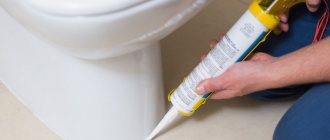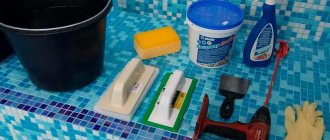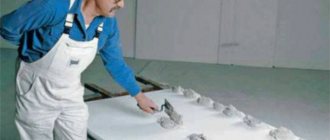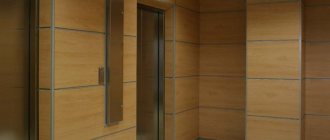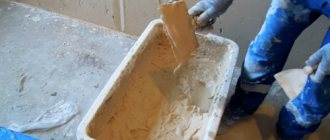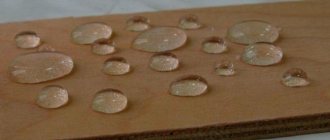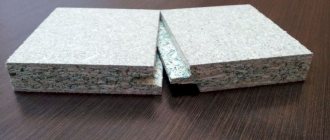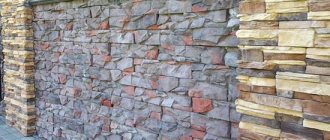In order to prevent water from entering the gap between the bathtub and the wall, and therefore the spread of mold, it must be sealed. There are several methods on how to do this. You can use pieces of ceramic tiles, plastic corners and silicone, baseboards, and border tape. What is the latter? How is it better than other options? What are its disadvantages? How to glue border tape in the corners of a bathroom? More on this and much more below.
Border tape
Main characteristics
The border tape has a plastic structure, thanks to which it adheres well even to uneven wall surfaces. High-quality fixation is ensured by a special applicator on the edges of the product. When used, the tape is at an angle, which ensures that water falling on it drains into the bathroom. Throughout its entire service life, the bathtub tape retains its flexible, strong structure, does not get wet or crack.
Bath border tape
To install the tape, a complete set of materials is purchased, which consists of:
- curb tape rolled into a roll;
- special knife for cutting;
- corners (they are available in sets with curly ribbons);
- applicator.
Border tapes are available in a wide range in construction stores and specialized markets. Prices for the most popular curb models are shown in the table:
| Manufacturer | Dimensions, mm | Cost, rubles |
| MakroPlast LWE | 20x340 | 520 |
| MakroPlast LWE | 30x340 | 700 |
| Ultima | 38x320 | 250 |
| Ultima | 30x320 | 280 |
| Unibob | 30x335 | 400 |
Installation steps
The process of installing adhesive tape is quite simple. You can cope with it without outside help. This is especially true for borders with an existing adhesive layer. The whole procedure will take no more than an hour. In some cases, more time may be required to prepare the surface.
Preparatory work
The most important part of the instructions for installing curbs is the preparatory work. If you make a mistake at this stage, the reliability of the glued tape will be extremely low. You should approach your work as responsibly as possible.
Preparing the surface is not that difficult. If there is old tape stuck on it, it should be removed by removing any remaining sealant. The surface of the bathtub and the wall where the border will be glued must be degreased with an alcohol solution, diluted soda or a gentle cleaning agent.
After this, you will need to wipe the surface with a thick cloth or dry it with a hairdryer. It is better to use the second option, as it is more reliable.
Tools
Before gluing borders, you need to make sure you have all the tools and materials. Without them it will not be possible to complete the work. In addition to borders, you should prepare:
- mounting knife;
- roulette;
- masking tape;
- pencil;
- sealant;
- putty knife.
If you use regular tape without an adhesive layer, you will need to additionally purchase acrylic sealant or glue. They will be used to connect the border to the wall and the bathroom.
Cutting strips
A very important step is cutting the strips. The adhesive tape must match the length of the tub and its width. You need to measure the necessary parameters and mark the cut locations. When cutting the tape, keep in mind that it should be 2 cm longer than the curb of the bathtub. Also, after this, it should be bent along the fold line and the lower corner should be cut off at an angle of 45°.
This is interesting: How to align the corners in the bathroom - we present it in detail
Which border tape to choose
Self-adhesive tapes are made primarily from synthetic polymers, due to which they differ in the necessary performance characteristics: moisture resistance, elasticity, resistance to temperature changes and household chemicals. Manufacturers apply a butanol-based adhesive to the back surface of the tape. The shape of the borders can be angular or curly. They go on sale in the form of rolls, complete with an applicator and sometimes a construction knife.
Installation of curb tape for the bathroom
Curved borders should also be equipped with a pair of corners.
When choosing a border tape, pay attention to several important nuances
Width. A tape that is too narrow may not be enough to cover the seam, and if it is too wide, the bathroom will look sloppy. The length of the material in a roll is usually within 3.5 meters. This is quite enough to cover a rectangular bathtub on three sides, and an asymmetrical or corner bathtub on two sides, respectively.
But in any case, it is better to take all measurements in advance. There can be a wide variety of color options, but white remains the priority for manufacturers, so other shades often have to be searched for or purchased to order. Few people pay attention to the fact that curb tape has a shelf life, which, as a rule, does not exceed two years. When the material is stored in an unacceptable temperature range or the packaging is damaged, the self-adhesive layer dries faster.
This is interesting: Carpet on the floor
Types of border tape
Colored options for adhesive tape
Bathroom sealing tape is made of polyethylene and does not have any design variations as such. But for ease of selection, this material is conventionally divided into types according to a number of external features and installation technology. These signs include:
- Product width. Adhesive tape for the bathroom has a range of sizes in width so that you can choose the appropriate material for a specific seam thickness. In the vast majority, the kit includes a strip 320 or 350 millimeters long. There are tapes in widths of 20, 40 and 60 millimeters. This length is quite enough for the sealed border tape for the bathroom to completely cover three sides of a standard font, the length and two end sections.
- Product color. Most tapes are made white by default, but in large plumbing stores you can find a wide range of different colors. Colored border tape for the bathroom allows you to choose the material to match the color of the interior or as close as possible to it.
- Installation method. The vast majority of products are manufactured with a self-adhesive surface, which allows the tape to be mounted without additional adhesives. But there are models that do not have an adhesive side and such a sealing tape for the bathtub is mounted on neutral silicone or acrylic sealant.
- Decorative design. It is rare to find products on sale that have figured trimming or even decorative embossing, but such figured border tape for the bathroom is not particularly popular due to its inflated cost.
The differences described above can be called conditional, but it is necessary to know them in order to select the appropriate model for a particular case. You can see what waterproofing tapes look like in the photo in the article.
Types of border tape
In the manufacture of self-adhesive tapes, predominantly synthetic materials are used. Thanks to this, bath borders have the following technical characteristics:
- Elasticity.
- Moisture resistance.
- Resistant to household chemicals.
- Resistant to changes in temperature and humidity.
These are the main criteria when choosing material for bathroom cladding. Many manufacturers are engaged in production, so the choice should be approached responsibly. Study reviews and choose curb tape only from trusted suppliers.
Three rolls of border tape
Bath borders are supplied to the market by the manufacturer in the form of rolls and have an adhesive composition on the back side. Also included is a special applicator, with which you can easily highlight the joint angle. If we talk about varieties of products, then you need to understand that they are absent.
Here are a few key points that make the self-adhesive border a little different:
- Form. The tape can be angular or figured. The figured tape has a middle longitudinal sector, on which there is no adhesive composition.
- Width. The width should be selected depending on the size of the gap formed.
- Length. Rolls of 3.5 meters are usually sold. This is enough to cover a bathtub, but it’s better to take measurements before purchasing.
- Colors. According to the standard, the tape always comes in white. However, in specialized stores you can find border tape in pink, turquoise, beige and other shades.
The border tape can be made in different colors.
These are the main differences that this product can boast of.
Before purchasing, make sure that the border tape is designed to seal the seam between the bathtub and the wall
If you are interested, then you can read the recommendations on choosing a bimetallic radiator.
What is a bath border?
The main purpose of a bathtub curb is to protect the joint between the sanitary ware and the wall from moisture getting inside. Stagnant water can cause the appearance of fungus, mold, and insects. Therefore, in the manufacture of border tape, exclusively water-resistant, water-repellent materials are used.
Self-adhesive tape is made from polyvinyl chloride, which is resistant to acids, alkalis, and mineral oils. PVC is used in the manufacture of wallpaper, refrigerator seals, and various building materials. The water resistance of PVC and its resistance to temperature changes ensure airtight, reliable sealing of the joints between the wall and the bathtub. The products contain fungicides that prevent the development of mold and also repel insects, such as ants, which are sometimes found even in residential buildings.
The inner side of the border is usually treated with butyl glue, which prevents spontaneous peeling of the tape throughout its service life. Butyl glue is resistant to moisture and temperature changes.
Characteristics of border tape
Modern manufacturers offer a wide range of different decorative disguises for such gaps. Among them, bathroom border tape has become quite popular. It is an adhesive-based strip made of polymers. This material is highly resistant to various persistent chemicals and acids. In addition, such decor is hydrophobic and does not contribute to the emergence of harmful microorganisms on its surface.
This is what self-adhesive bathroom curb tape looks like
This sealant is affordable and easy to install and dismantle if necessary. In addition, the material has a rich color palette and looks very attractive throughout its entire service life.
The scope of application of polymer strips is very wide. They can be used in almost any room with different functional purposes. Therefore, when purchasing a product, check where you plan to use it. In the bathroom, border decors can be used to decorate the seams between the walls and any plumbing fixtures, including shower boxes and washbasins.
The product is produced in small rolls about three meters long.
The product is released in bundles. The length of one such roll is about three meters. In this case, the thickness and width of the decor may vary. The entire back surface of the strip is impregnated with butyl adhesive, which will allow it to be hermetically installed on the problem area. The material itself is quite hygienic, although for reliability it is impregnated with antifungal additives, which prevent the occurrence of mold at the joint seams.
Among the polymer analogues presented for these purposes, decorative borders will be the best choice. Other plastic skirting boards will not be able to resist the proliferation of fungal microorganisms as effectively. As for the complete sealing of the joint with tiles or porcelain stoneware, such an undertaking will require lengthy work and certain skills in cladding. In addition, this material will cost significantly more, and will require additional measures to seal the seam.
Positive and negative aspects of the material
Self-adhesive curb tape for the bathroom leaves mostly positive reviews from users. After all, such decor has many advantages. The main advantages of this material are:
- affordable price;
- speed and ease of installation;
- versatility;
- good resistance to loads and mechanical damage;
- sufficient strength and hygiene;
- attractive appearance.
All of the above properties are not an exhaustive description of this decor, but explain its popularity. In addition, polymer sealing strips are resistant to moisture and high temperatures, which is so important for their use in the bathroom. They are very flexible, so they can be used not only on rectangular, but also round bathtub configurations. At the same time, the joint line looks impressive and neat.
An important nuance will be the possibility of installing the tape yourself. This does not require special knowledge or experience of similar work. Even an ignorant person in construction who does not have a professional set of tools can reliably seal the joint.
The resistance of this product to chemicals so often used to clean bathtubs has also received excellent reviews. The top layer of coating does not react with aggressive elements. Accordingly, it does not lose its aesthetic appearance and functionality throughout its entire service life. In addition, even with minor damage to the surface, the tape will remain firmly attached and will not delaminate.
Any owner can easily apply such decor
Of course, with all the undeniable advantages, these decorative stripes also have negative characteristics. The first thing that should be mentioned is the fragility of such material. Manufacturers usually provide a one-year warranty on the product, although in some cases, with careful handling, the tape can last up to five years.
The second negative property will be the possibility of reacting with acid-based substances. This can lead to the loss of the original attractive appearance and even the border coming off. Therefore, you should not abuse such products when cleaning the bathroom.
In a word, closing the gap with self-adhesive tape is an effective and reliable, but temporary measure. Although, given the affordable cost of the material, it will not be difficult to periodically replace the old decor with a new one.
Installing the tape at the joint
First apply the tape and measure the required lengths
In order for the waterproofing tape for the bathroom to serve for a long time, it is necessary to strictly follow the sizing technology. To better describe the process, we will provide step-by-step instructions and at the end of the article we attach video material that will show everything clearly. So, the installation process looks like this:
Bathtub adhesive tape is laid starting from the longest section of the joint. To do this, we measure the segment we need by leaning it against the long section and cut it off with a utility knife.
It is very important here that the adhesive tape for the bathroom is measured without tension, otherwise you will end up with an uneven edge. Then we bend the border tape in half along the entire length of the segment so that its adhesive side is on the outside. Then we remove about 5-6 centimeters of the protective film from the adhesive surface and glue it clearly to the joint, starting from the corner. Then unroll the tape and, using a rubber spatula or finger, press the remaining parts to the surfaces as firmly as possible
The harder you press, the stronger the silicone bathroom tape will be glued to the joint. After the first section (5-6 cm) is glued, remove another 3-4 centimeters of the protective tape and glue it again. And so on along the entire length of the segment.
Installing mounting tape at the joint
- In the same way, measure and glue the remaining sections of the joint. In places of corner joints, pasting is carried out overlapping the previous layer.
- At the end of the pasting, the bath border tape is cut at the corners with a stationery knife at an angle of 45 degrees. In this case, the depth of the cut should affect both tapes, after which we leave it all for 24 hours for the material to completely shrink.
If after 24 hours you find that the tape around the bathtub has come off in some places, then most likely these places were damp or not sufficiently degreased. In this case, you can glue these areas using liquid nails or any other high-quality glue. If you use a wide curb tape for the bathroom, then it is advisable to install it at a temperature not lower than +10 degrees, and also avoid low temperatures during the shrinkage of the material throughout the day.
After reading the material presented in the article, you already know how to install polyethylene or silicone tape for bathtubs and will be able to carry out the installation yourself.
Basic details of use
Using a self-adhesive border is a quick way to solve the problem of sealing the joint between the bathtub and the wall. However, after 1-3 years, the PVC tape will have to be replaced, so if you have the money and time, it is recommended to choose more durable border options, for example, made of ceramics. However, the availability and high sealing properties of self-adhesive tapes ensure high demand for such products. However, the use of borders has its own characteristics, knowledge of which will protect you from mistakes and rapid damage to the product.
Before installing the curb tape, the surface must be thoroughly cleaned
Fixing the curb is carried out only on cleaned and degreased surfaces. If this rule is not followed, the tape will not fit tightly. When using a product with a width of 6 cm, installation must be performed at a temperature of at least 10? C. During the drying period, low temperatures in the bathroom are also unacceptable.
The tape is glued in small sections. Each of them needs to be pressed for at least 15-20 seconds, during which time the glue will set sufficiently and the connection will be strong. After the adhesive base has dried, the border can be wetted with water or cleaned by any means.
Before gluing, the protective layer is removed from the border tape
Even with the best quality plumbing installation, there is always a gap between the products and the wall. Water can accumulate inside the smallest crack, which will cause damage to the plumbing product and wall decoration. Decorative borders for bathtubs are designed to seal gaps and add completeness to the interior. Depending on the color of the walls or floor, you can choose a white or colored border, smooth or figured. The different widths of the tape models allow you to choose the optimal size, slightly larger than the width of the joint between the wall and the bathroom. The simple process of fixing the tape is accessible even to a beginner.
Gluing border tape
The main advantages of using border strips
Border tape is the most affordable and easy-to-install material. Numerous consumer reviews speak of the advantages of this method of joint sealing. Here are their main advantages:
- Affordable price.
- Quick installation. Anyone can glue it.
- Reliable sealing of seams.
- Due to the fact that the adhesive composition is applied over the entire surface of the tape, it adheres perfectly to the surface of the side of the bathtub and the wall.
- It does not wrinkle under loads, it is resistant to various damages and impacts.
- It has a high degree of plasticity, it bends perfectly at any angle, and no cracks form on it.
The disadvantages of the material include its fragility. Unlike ceramic curbs, which can last for decades, a flexible bathtub curb will need to be replaced after 2-3 years. However, due to the affordable price and ease of installation, the need for replacement will not create any special problems.
Advantages
The tape border is in great demand among buyers. In addition to the affordable price, self-adhesive curb tape has many advantages:
- if the installation rules are followed, the curb provides a durable, reliable sealing of the seam between the wall and the bathtub;
- high elasticity allows you to lay the tape on bathroom walls not only on flat surfaces, but also, if necessary, on curved ones;
- the curb has an affordable price and a service life of at least 2 years;
- the product is fixed to an adhesive base, which allows you to quickly and easily glue it with your own hands, including on glossy surfaces;
- The tape is resistant to mechanical stress; no chips or pits are formed on the surface, even with impacts.
The product requires simple care and cleaning using standard household chemicals for plumbing products. The only limitation is that the use of abrasive cleaners and hard metal brushes is not recommended. The PVC used in the production of such tapes is durable and elastic, and solid particles can damage or scratch it.
Types of border tape
Colored options for adhesive tape
Bathroom sealing tape is made of polyethylene and does not have any design variations as such. But for ease of selection, this material is conventionally divided into types according to a number of external features and installation technology. These signs include:
- Product width. Adhesive tape for the bathroom has a range of sizes in width so that you can choose the appropriate material for a specific seam thickness. In the vast majority, the kit includes a strip 320 or 350 millimeters long. There are tapes in widths of 20, 40 and 60 millimeters. This length is quite enough for the sealed border tape for the bathroom to completely cover three sides of a standard font, the length and two end sections.
- Product color. Most tapes are made white by default, but in large plumbing stores you can find a wide range of different colors. Colored border tape for the bathroom allows you to choose the material to match the color of the interior or as close as possible to it.
- Installation method. The vast majority of products are manufactured with a self-adhesive surface, which allows the tape to be mounted without additional adhesives. But there are models that do not have an adhesive side and such a sealing tape for the bathtub is mounted on neutral silicone or acrylic sealant.
- Decorative design. It is rare to find products on sale that have figured trimming or even decorative embossing, but such figured border tape for the bathroom is not particularly popular due to its inflated cost.
The differences described above can be called conditional, but it is necessary to know them in order to select the appropriate model for a particular case. You can see what waterproofing tapes look like in the photo in the article.
Types of borders
In accordance with the purpose of the product, there are no design varieties of models. Conventionally, several types of borders can be distinguished according to various characteristics:
- color - the most commonly used is white tape to match the classic color of the plumbing fixtures. But in stores you can find products in other colors: beige, pink, blue, green, which will harmonize with the color of the walls;
Border tape can be of different colors
- Dimensions - depending on the size of the bathroom and the width of the joint between it and the wall, choose the appropriate tape size. The standard length is 3.2 m or 3.5 m. This length is sufficient for laying on two transverse and one longitudinal parts of the bathroom. The width of the products can be 2 cm, 4 cm or 6 cm, the choice is made based on the width of the gap, so that a small margin remains. You should not buy the widest tape with the minimum gap, the bathroom will look untidy;
Border strip sizes
- type of installation - most buyers prefer self-adhesive tape, which can be installed between the wall and the bathroom without additional funds. However, there are products without an adhesive surface. For their installation, acrylic sealant or neutral silicone is used.
There are also varieties with decorative embossing or a figured edge. However, they are practically not represented in stores and construction markets due to their high cost and low demand among consumers.
How to make the right choice
In addition to its functional function as a sealing object, the tape also has a decorative function. It gives the bathroom a finished look; shaped, colored products increase the attractiveness of the interior. When choosing a suitable tape model, you need to evaluate several characteristics:
- width of the product - if there is a large gap, you should not purchase the narrowest model with a thickness of 2 cm, it may not be enough. An overly wide model may not look aesthetically pleasing. Therefore, you should purchase a self-adhesive border with a width equal to the width of the joint with a margin of approximately 10-15 mm;
- the standard length of the product does not exceed 3.5 m. For bathtubs of classic shapes, one roll is enough to seal joints on three sides, for corner, asymmetrical models - on two. If the font has non-standard dimensions, then more than one roll of tape may be required;
- colored, figured models have a more attractive appearance, but are rarely found on sale. The classic white color with a smooth texture will suit any interior.
Materials
The main criterion by which borders for bathtubs and sinks are chosen is the material of manufacture.
Polyethylene border tape for sinks and bathtubs
Reliably seal the holes from moisture. They are easy to use and cheap compared to other materials. There is a wide range of border tapes of different widths, lengths and colors. The tape has a self-adhesive base, so even a child can handle gluing such a border.
A significant disadvantage of such a border is its fragility. Such curbs are usually used as a temporary solution to the problem. If you want to extend the life of the curb tape and provide more reliable protection from moisture, you can additionally use a sealant under the tape. However, even with this method of use, the tape will last you several months, no more.
Plastic
The next longest lasting curb is a plastic curb. Made of very practical and at the same time inexpensive plastic, such a border is securely attached to the bathtub and wall using special glue. At the same time, plastic borders are very light and do not weigh down the structure; they are easy to install and easy to clean. They go well with any materials. However, such borders also have their drawbacks - the plastic can fade and darken over time, it is easily scratched, and soon you will also have to replace it.
Ceramic
It should be matched to the tiles used in the bathroom. Such borders are much more durable than those described above and can serve you for decades. Ceramics provide good sealing and are durable in themselves. However, you need to be careful - if installed incorrectly, the ceramic border may crack.
Installation of ceramic borders requires the use of special equipment and certain skills.
A natural stone
Such borders certainly require an appropriate interior. Marble and granite borders are almost eternal, but in a small bathroom lined with ordinary ceramic tiles, they will look ridiculous. They are quite bulky and require certain skills during installation.
Flaws
The disadvantages that the product has are less significant compared to the advantages of its use. The main ones are the following:
- short service life of the border for sealing the seam between the wall and the bathroom. The service life, depending on the intensity of use of the bath and the quality of the ventilation system, is 1-3 years. This is significantly less than other types of borders, for example, made of plastic or ceramic tiles;
- Replacing an old curb strip requires some effort in addition to material costs. The old product needs to be peeled off, the remaining sealant removed, the surface cleaned and degreased;
- When sealing the seam between the wall and the bathtub using a curb, it is worth remembering that its adhesive composition is incompatible with acidic silicones. If you use acidic silicone during installation, the tape will lose its shape and come off.
Despite the existing disadvantages, in a situation where it is necessary to seal a joint with minimal time and effort, it is recommended to choose adhesive-based PVC tape.
Device
Border tape is a special means for sealing seams, which is a long strip of polymer base, impregnated on one side with a butyl adhesive. It is sold in rolls up to 3 meters long. One package of this sealant is enough to seal the seams between the bathroom and the walls. Self-adhesive border tape has the following properties:
- Moisture resistance. The polymers from which the sealant for seams in the bathroom is made is not subject to the destructive effects of moisture. In addition, the sealing tape does not absorb water and repels it.
- Chemical resistance. The material from which the seal is made withstands the effects of aggressive household chemicals used to clean the bathtub.
- Stable adhesion. Thanks to the adhesive butyl layer and the active adhesion it has, the seal is firmly fixed on any type of finishing material.
Preparatory work
To ensure good adhesion of the material and the absence of moisture under the polymer layer, you need to properly prepare all surfaces. To prepare you need:
- remove the old curb tape if installation is repeated;
- remove dirt from the sides of the bathtub and the walls to which they adjoin (to prevent contamination from building materials, it is not recommended to remove the protective film from the sides before installing the bathtub);
- clean the wall and sides (the latter is not necessary for a new bathtub) using tile detergent or soda and soap;
- degrease the surfaces with alcohol or gasoline (it is not recommended to use other solvents, especially if the bathtub is made of acrylic);
- wait until completely dry or thoroughly wipe the wall and sides with a dry, clean cloth that does not leave lint;
- prepare sections of the required length;
- If you have no experience, study the instructions and training videos.
It is recommended to warm up the polymer layer before gluing. This will make it more flexible and convenient for installation.
The optimal temperature in the bathroom during gluing is +10…+20°C.
Benefits of using border tape
Using curb tape to seal joints in a bathroom is a common option as it is a cheap and easy method. Bathroom border tape has a short service life and does not tolerate the presence of acidic silicones. The polyethylene from which border tape is made has many advantages.
The advantages of curb tape include the following factors:
- low cost of material;
- ease of installation;
- neat appearance;
- reliable protection against moisture;
- the material tolerates temperature changes well;
- prevents the development of mold and mildew;
- perfectly hides uneven joints;
- does not crack under shock loads;
- not exposed to household chemicals;
- has an optimal balance of flexibility and rigidity;
- high ductility (easy to fit both on rectangular joints and on curved planes).
Border tape is supplied in the form of compact rolls.
A number of enterprises around the world are engaged in the production of these tapes. They create high-quality moisture-resistant material that meets sanitary standards. This cladding element is supplied to the market in the form of compact rolls in the manufacturer's packaging.
Preparing for installation of curb tape
Preliminary sealing of a wide seam with sealant
Before gluing the tape to the bathtub, a number of preparatory work is required to ensure the proper level of adhesion and reliable waterproofing. The fact is that the curb tape for the bathtub is not installed over a gap that exceeds 2 millimeters; such a gap must first be sealed. Further steps to prepare the surface are carried out according to the following scheme:
- Preliminary sealing of the seam. Many craftsmen, before gluing the tape to a bathtub with a large gap, initially seal it with acrylic sealant or tile adhesive. This is necessary because if there is a void under the curb, it can be easily damaged by pressing with a finger. In addition, this free space without proper ventilation will become a source of mold.
- Surface cleaning. Self-adhesive bathroom tape requires a perfectly clean and grease-free surface; only in this case is a tight fit and complete insulation of the joint guaranteed. The joint must be cleaned of dust and dried well using a hair dryer or a hair dryer.
Once all these steps have been completed, you can begin installing the bathroom curb.
Important. If the tape does not have a self-adhesive surface and a special adhesive solution is included with the product, then installation of the border tape on the bathtub is carried out after preliminary priming of the joint area
How to properly glue border tape to a bathtub: the correct technology and sequence of work
The process of gluing the material is carried out as follows:
- Initially, you should take measurements and mark on the tape the size of the edge of the product, making an allowance for the corner joint, if any.
- The cut part of the material must be folded in half or along the visible creases with the glue side facing out. To increase elasticity and make installation work more comfortable, you can additionally warm it up using a hairdryer.
- According to the rules, it is necessary to paste the tape in the corners, then along the length and, last of all, along the width of the bathtub, gradually removing the protective coating.
Note! If you need to glue two corners, then first of all you need to install a larger section, then the corners and then the remaining section.
- Next, you need to gradually separate the protective strip 12-15 cm from the adhesive layer so that you can apply it to the joint in time, pressing tightly against two surfaces, but initially against the bathroom.
Important! When laying the material, do not allow it to stretch, only pressing it against the smooth walls. In addition, in the process of gluing the border tape, it is necessary to regularly monitor the quality of the fit, which is especially important when installing it on uneven surfaces, seams and tiles with various defects.
- The material in the corner of the bathtub should be laid on top of each other, fixing it to the wall, and the border on the product should be cut at an angle of 45°. Next you need to glue it to the bathtub by removing the protective coating.
It is recommended to avoid getting water under the tape for 24 hours, and if after this time it is possible to identify places with inadequate adherence to the tile seams, it is required to paste it using liquid nails or sealant.
